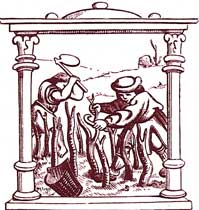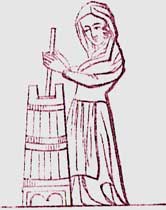Medieval Food
Medieval food had bread as its main component. In the earliest times, bread was cooked under the embers. The use of ovens was introduced into Europe by the Romans. However, the old system was still used even in the 10th century. By feudal law, the lord was bound to bake the bread of his vassals, for which they were taxed, but the vassals preferred to cook their flour at home under the embers. As the custom of leavening the dough by the addition of a ferment was not universally adopted, they were careful to make their loaves very thin, so they can be thoroughly cooked. Those loaves served as plates for cutting up the other food upon, and when they became saturated with the sauces and gravy they were eaten.

Culturing The Vine
It is difficult to point out the exact period at which leavening bread was adopted as an essential food of the European Middle Ages. Yeast was reserved for the pastry, and it is certain that only at the end of the 16th century the bakers of Paris used it for bread. In the 14th century France, the most celebrated bread was the white bread of Chilly, a village ten miles south of Paris. It was a must for all the tables of the higher classes. Rye bread was held of very little value, but at a latter period, the doctors of Paris frequently ordered the use of bread made half of wheat and half of rye as means of preserving health.
Medieval food basics
- Vegetables and plantsFresh and dried vegetables were part of the ordinary food. However, they were never considered as a solid nutrient, and they were used almost exclusively by monastic communities, when under vow of abstinence. Generally speaking, the vegetables used in the 15th century were almost the same as in the times of Charlemagne, plus the vegetable-marrow and the recently imported artichoke. About the same date, the melons begin to appear on the menu.
The cabbage was of many kinds and a much appreciated food during the Middle Ages. In France, the one held in the highest reputation was the famous cabbage of Senlis, whose leaves, it is said, when opened, exhaled a smell more agreeable then musk or amber. Cucumbers, though in request, were not considered a wholesome food by the Medieval experts. Lentils, now considered so wholesome (think of the organic lentils recommended nowadays by all nutritionists!), were looked upon as a doubtful vegetable. Turnips were most esteemed by the Parisians, and also the lettuce. The people of the Middle Ages enjoyed salads, and any banquet had at least three or four different kinds on the menu (which is not bad at all!).
Pears, apples, or plums were among the most appreciated fruits, and an essential part of daily meals. Great progress has been made in the culture of these fruits, and as early as the 13th century, there was a great variety of them. The quince was looked upon as the most useful of all fruits. It formed the basis of the farmers' dried preserves, but it was also used for seasoning meat. Several sorts of cherries were known, the small wild cherries being preferred. In the 13th century, chestnuts were hawked in the streets. Orange trees are mentioned as early as the 1300s. Raspberries were still wild in the 16th century.
The grapes were acclimatized by the Gauls after being brought from Italy. By the end of the Middle Ages there are mentions of 19 sorts of food (or table) grapes. They were eaten fresh or preserved by drying in the sun or by exposure to artificial heat. The same means were adopted for preserving plums. It was also a custom to dry apples in the oven, which were consumed in the winter as a delicacy.
- MeatMedieval people's food relied heavily on pork meat. During those times, when the land was still covered with huge forests of oak, great facilities were offered for breeding pigs, making pork the most consumed meat. Bishops, princes and lords fed numerous pigs on their domains, both for their own tables as well as for the fairs and markets. Later, it became the custom for each household, whether in town or country, to rear and fatten a pig which was killed and salted at a stated period of the year. In the Middle Ages pork made the greater part of food at domestic banquets. There was not a great feast without hams, sausages, and black puddings being served on all tables. The enormous consumption of pork led to sanitary measures being taken in Paris and in other towns, and public officers were ordered to examine the animals in order to ensure they were fit for consumption.

Churning The Butter
Beef was the other Medieval essential red meat, a food especially popular with the Normans. There were regulations meant to ensure the meat was of the best quality and in a healthy state. A butcher for example could not sell meat unless "it was previously seen alive by two or three persons, who will testify to it on oath." To the many regulations affecting the interests of the public must be added that forbidding butchers to sell meat on days when abstinence from animal food was ordered by the Medieval Church. In the same time, the trade of a butcher, to which extraordinary privileges were attached, was obtaining the greatest profits.
- PoultryMedieval people highly appreciated poultry. In France, the trade in fattened geese (foix gras anyone?) dates from as early as the Gauls' times. The breeding of geese for food was carefully maintained during the Middle Ages. For many centuries, geese were more highly prized than any other poultry. Following the tradition, one item in the households of the kings of France was the poultry house or yard. It can be also found in the inventories of the nobles' households, and of those of the bourgeois. Capons are frequently mentioned in the 12th and 13th centuries. Peacock's meat was usually served with great pomp during the chivalric banquets. In the 13th and the 14th century, the poultry yards were stocked with these birds.
During the Middle Ages they even fattened pheasants for food the same way as they did with capons. Swans were much appreciated, and it was not only a matter of taste , but also of convenience, as they were very common on all the principal rivers of France, especially in the north. After being avoided for a long time, the young game became a delicacy served at the banquets.
- Rabbit meatEveryone in town or country reared domesticated rabbits, and the wild ones were also much in request. Hares were preferred to rabbits, provided they were young.
- Dairy products: milk, butter, eggs, cheeseDuring the Middle Ages diary food was consumed fresh or preserved. Butter was eaten fresh, sometimes mixed with garlic. It was salted in order to preserve it, or to send it to distant places. Salted butter was enclosed in earthenware jars, particularly by the Normans and Bretons. In the 12th and 13th centuries, the cheeses of Champagne and Brie were very popular, and were hawked in the streets.
Medieval food preservation
- FishIn the Middle Ages, everybody was abstaining from eating red meat on Fridays, thus fish was the meal of choice for those days. As a result, demand was high and not everybody had access to fresh fish. The salted fish is an interesting example not only as a method of food preservation, but also as a source of great profit for those involved in trading the product. The Hanseatic League is proof of a great commercial and political power built on the trade of preserved food.
Freshwater fish was the food of choice for Medieval people living on the borders of lakes, ponds or rivers, or for those who were close enough to procure it fresh. In the 1200s and 1300s, the barbel was held in great estimation. The pike, the lampreys, the trout, and the carp, were also popular.
During the Middle Ages the development of trade had a major contribution in diversifying the food. The trade in salted sea-fish began in Paris in the 12th century, especially salted herrings and mackerel. In addition, flat-fish, salted whiting and codfish were preferred. In the 14th century, among the recipes for cooking fish, there are mentions of the salted flesh of whale. This coarse food was only eaten by the lower orders, as it was hard and indigestible. The inhabitants of the coast at all periods ate various kinds of shell-fish.
With the development of Medieval commerce many food delicacies were introduced, and, for example, towards the 12th century, oysters were brought to Paris, however mussels were not known there until much later.
